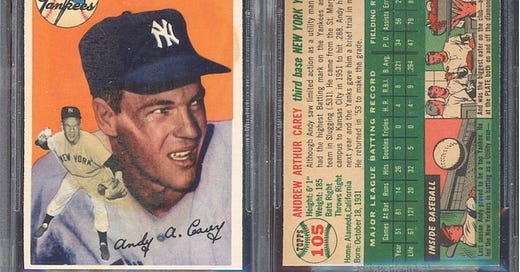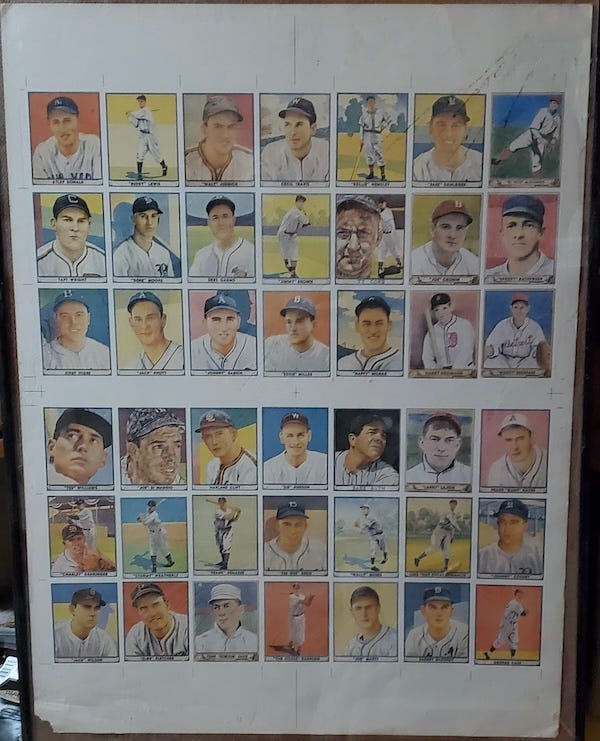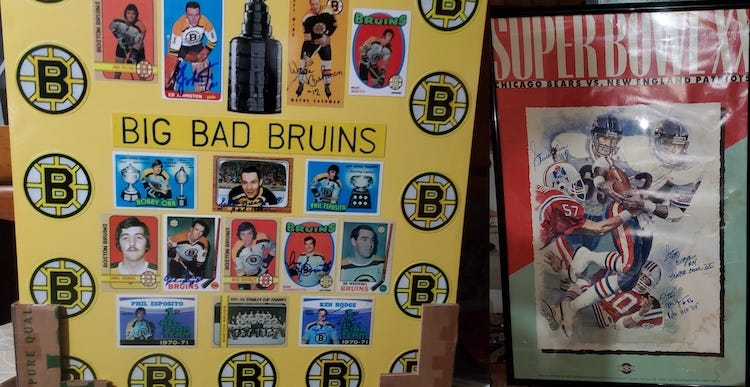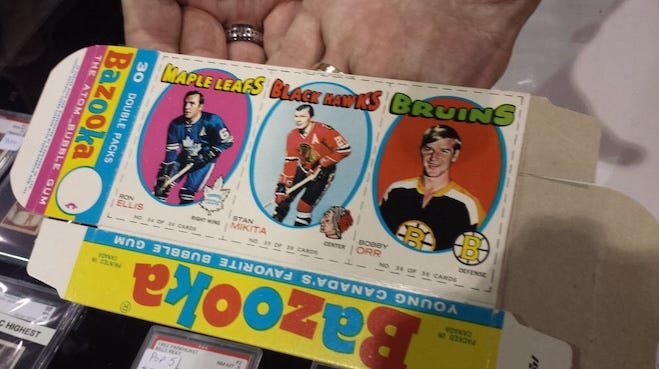The Post War Cards Newsletter #25
A 1941 Play Ball Uncut Sheet (Sort Of), Gary Carter's Fleer Photos, 1971 OPC Bazooka Bubble Gum HK Boxes, The 1968 Topps NBA Test Uncut Sheet, And Andy Carey's 1954 Topps File Copy Card
Happy Thursday, collectors!
Remember, you can upgrade your subscription for just one month, for $8, to see if you like the unopened market report. If you do, you'll get access to the full archives!
⚾️ A 1941 Play Ball Uncut Sheet…Sort Of
A couple of weeks ago, a collector sent me the following photo, asking me to help identify it.
At first glance, the cards look like the 1941 Play Ball Paper Sheets I shared on the blog. But a few cards looked out of place, like the Joe DiMaggio, 2nd column, and 4th down. So I went to TCDB, looked at DiMaggio’s player page, and discovered it’s an uncut sheet from the 1977 1941 Play Ball Reprint Set. On the TCDB page, a collector commented that the set had 72 cards from the original 1941 set and 10 colorized versions of cards from the 1940 set, with a few exceptions on some of those, like DiMaggio, Williams, and Gehringer included a superimposed picture. Also, the Ty Cobb and Babe Ruth cards are checklists.
The cards are inexpensive, but I mentioned that there probably weren’t too many sheets printed. There are quite a few uncut sheet collectors, so it could be a $100-200 item, but I’m not the best estimator for niche items like this (as you’ll read later in this newsletter).
The owner told me he got it from a guy who collected for 60+ years, was a dealer, and actively sought autographs. He had over half a million cards on three floors and 12 rooms, along with some cool fan-made displays, like the “Big Bad Bruins” one below.
If you’re interested in helping the new owner out by picking up a bunch of the items or would like to see more photos, shoot him an e-mail.
🤬 The Photo Used On 1989 Fleer Baseball Boxes
I never noticed this before, and maybe you haven’t either, so thank you to Mark Sommer on X, who shared on March 2nd that the 1989 Fleer Box photo appears to have originated from the 1985 Fleer Update photo.
I’m a little embarrassed not to know this since the most visited article on the blog is about Pulling the Bill Ripken FF Error from 1989 Fleer Wax Boxes. As a reminder, there’s no indication on an individual box about which Bill Ripken card will be inside; it has to do with case codes.
✍️ Great Hobby Writing
SABR's Baseball Cards Research Committee: Hometown Heroes
Signature Stories: Tournament time with the Hoyas
Collectibles on SI: How Many of These Impossible (and Valuable!) 1980s Baseball Cards Did You Have?
Topps Ripped: NY Yankees Collector | Sooz Lulgjuraj
Sports Collectors Digest: Babe Ruth’s 1934 tour of Japan left behind a baseball legacy, plenty of collectibles
The Chronicles of Fuji: Blog Bat-Around: Junk Wax Favorites
🏒 Unopened Item Of The Week - 1971 O-Pee-Chee Bazooka Bubble Gum Box With Hockey Cards
In 2017, Classic Auctions sold a 1971-72 OPC Bazooka Bubble Gum Box with three hockey cards on the back panel (Kurtenback, Nevin, and Cournoyer) for $771.97. The box was originally full of bazooka bubble gum, not packs of cards.
Then, in January this year, the box showed up for sale on Facebook with an asking price of $4k, which was then lowered to $3k. It’s now available on eBay for $2,999, which, in a way, looks like a bargain. You see, in 2015, Sports Collectors Daily highlighted the sale of what’s likely one of only a handful of others in existence that sold for $16k at the National Collectors Convention that year. However, that one does feature just a stronger lineup of Ron Ellis, Stan Mikita, and Bobby Orr!!!
If you want to read about more ultra-rare unopened pieces, consider upgrading your subscription to get Monday’s Unopened Market Report. Last Monday’s included a pair of (empty) 1952 Topps Baseball Wax Cases!
📝 On The Blog
Feb 6, 2025: Vintage Baseball Card Sales Numbers And The Topps Monopoly
Feb 7, 2025: The 1934 Gold Medal Foods Set And Its Original Envelope
Feb 8, 2025: World Series Special – Topps Captured The Moments
Feb 9, 2025: Exploring the Cosmos: Two Topps Space Cards Original Artworks
Feb 10, 2025: The 1979-80 OPC Hockey Set Isn’t Great Only Because of The Gretzky Rookie Card
Feb 11, 2025: The Backbone Of The Amusement Arcade Business: Exhibit’s Cards For 1955
Feb 12, 2025: TCMA’s Early Days: A Look at Their 1972 Advertisement in The Trader Speaks
📰 In The News
Sports Collectors Daily: Sale Of Wembanyama Jersey Swapped With Youth Wound Up In Different Court
Sports Collectors Daily: Uncut Sheet of Rare 1960s Topps Baseball Test Set Uncovered, Heads to Auction
Sports Collectors Digest: Goldin adds private sales platform for collectors
Collectibles on SI: Paul Skenes Rookie Debut Patch Auto Hits Auction Block – Could It Set a Record?
cllct: PSA pauses submissions from Canada, China, Mexico after tariffs take effect
Sportico: Fanatics, Panini Legal Battle Continues as Judge Nixes Dismissals
Sports Collectors Daily: Counter Tariffs Expected To Drive Up Hockey Card Prices In Canada
cllct: Beckett Collectibles sues two in fake memorabilia ring
Sports Collectors Digest: Fanatics Live launches new breaking experience featuring modern baseball card packs
🏀 The 1968 Topps NBA Test Uncut Sheet
Like I said earlier, I’m not the best estimator of niche item prices, especially uncut sheets. In The Post War Cards Newsletter #14, I highlighted the 1968 Topps NBA Test Uncut Sheet that was consigned to Heritage Auctions. I mentioned that a $500k sales price was possible.
Well, on February 23rd, it sold for $128,100. Perhaps it’s a little TOO niche to command a half-million-dollar price tag, but it’s still a big sale. Too bad there’s no database (that I know of) sharing the most expensive uncut sheet sales of all time!
Also, Heritage said the 27’’x 21’’ sheet was the first they’ve seen and was likely used to secure licensing rights or as a promotional tool. However, it could have just been a printer’s test sheet, right? The Topps Archives, in their piece Double Dipper, also thinks it’s a final production piece.
🏛 From The Topps Archives - 1954 Topps Andy Carey
Since a few folks mentioned that they enjoyed seeing the Topps Vault File Copy football cards I shared in The Post War Cards Newsletter #24, for a little while, I’m going to be sharing cool items from the Topps Vault rather than hobby library items; here’s a cool one from the 1954 Topps set; Andy Carey’s card #105 that was pasted in such a way to highlight the back (stain on front); on February 26th, it sold for $100 on eBay
It did include a Topps Vault Certificate of Authenticity from Mike Jaspersen.
Happy collecting!












Sorry for the early release! I thought I was scheduling NL 25 for Thursday, but must have hit publish accidentally!